October 16, 2015
Air Date: October 16, 2015
FULL SHOW
SEGMENTS
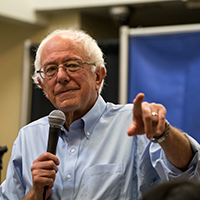
Democrats Debate Climate Change
View the page for this story
The Democratic presidential candidates recently squared off in their first debate. All five hopefuls spoke on climate change and the need for action, but differed on how to address the issue. Host Steve Curwood recaps their statements and looks back on a conversation with Vermont Senator Bernie Sanders about carbon tax and the climate bill he introduced in 2013, a plan that was referenced in the debate. (12:00)
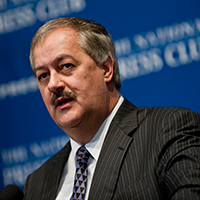
The King of Coal On Trial
View the page for this story
Former Massey Energy CEO Don Blankenship is on trial in connection with the deadly 2010 Upper Big Branch mine disaster in West Virginia. Mother Jones writer Tim Murphy recently profiled the coal baron, and speaks with host Steve Curwood about how this one man came to gain and then lose so much power over West Virginia’s economy, politics, and environment. (14:05)
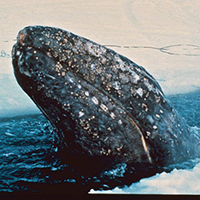
Beyond the Headlines
/ Peter DykstraView the page for this story
In this week’s trip beyond the headlines, Peter Dykstra warns host Steve Curwood that though an overnight deep freeze as portrayed in the movie “Day After Tomorrow” is impossible, Atlantic sea currents seem to be changing. He also describes Donald Trump’s recent anti-wind farm campaign near his Scottish golf resort. Traveling back in the history annals, we remember two prominent tales of whales. (04:15)
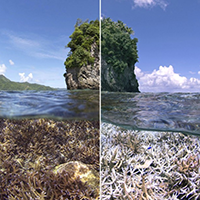
Coral Bleaching On the Rise
View the page for this story
NOAA recently announced that corals around the world are undergoing severe stress and a die-off due to globally warming oceans. NOAA’s Coral Reef Watch program coordinator Mark Eakin describes how the current El Niño, climate change and a Pacific warm water “blob” combined are stressing corals and why bleaching events are likely to be worse in the future. (07:20)
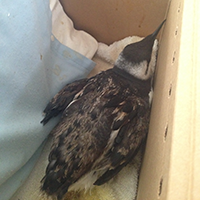
The Pacific Coast's Starving Seabird Mystery
/ Emmett FitzGeraldView the page for this story
Since the beginning of August, a seabird called the common murre has been washing up in droves on beaches from Southern California to Alaska. Living on Earth’s Emmett FitzGerald reports on the efforts in California to save the birds, and the latest scientific theories about what’s going on. (09:45)
Show Credits and Funders
Show Transcript
HOST: Steve Curwood
GUESTS: Tim Murphy, Mark Eakin, Tim Murphy
REPORTERS: Peter Dykstra, Emmett FitzGerald
[THEME]
CURWOOD: From Public Radio International, this is Living on Earth.
[THEME]
CURWOOD: I'm Steve Curwood. The Democrats who would be President debate in Las Vegas and global warming and policies to deal with the threat come front and center.
O'MALLEY: I have put forward a plan to move America forward to a 100 percent clean electric grid by 2050. We did not land a man on the moon with an all-of-the-above strategy. It was an intentional engineering challenge, and we solved it as a nation. And our nation must solve this one.
CURWOOD: Democratic solutions to the climate crisis. Also, with unusual warmth in the Pacific off the west coast, the crisis facing one small seabird.
BERGERON: We thought releasing 19 murres we were actually going to see a decrease, and then we got 30 in yesterday, so we’re not at the end of this, and we gotta just keep going until all these birds have been taken care of.
CURWOOD: Those stories and more this week, on Living on Earth. Stick around.
[NEWSBREAK MUSIC: Boards Of Canada “Zoetrope” from “In A Beautiful Place Out In The Country” (Warp Records 2000)]
ANNOUNCER: Support for Living on Earth comes from United Technologies – innovating to make the world a better, more sustainable place to live.
Democrats Debate Climate Change
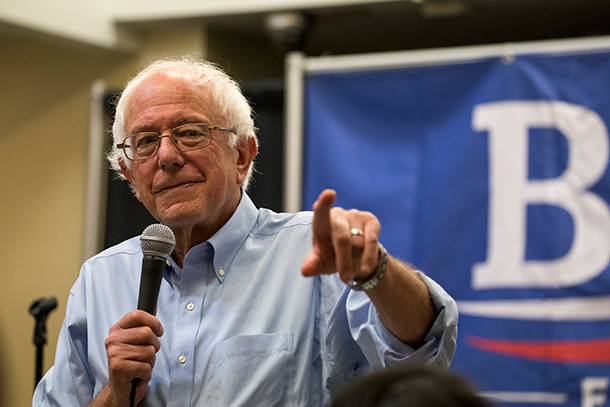
In the first Democratic presidential debate for the 2016 election season, Bernie Sanders singled out climate change as the, “greatest national security threat,” facing the U.S. (Photo: Phil Roeder, Flickr CC BY 2.0)
CURWOOD: From the Jennifer and Ted Stanley Studios at the University of Massachusetts Boston and PRI, this is Living on Earth. I’m Steve Curwood. The recent debate among the Democratic Party candidates for president hosted by CNN in Las Vegas set a precedent for the debate season and perhaps the campaign as well. Every one of the candidates directly addressed climate change, and unlike the 2 Republican debates so far, where it was scarcely mentioned, four of the five democratic contenders referred to it in their opening remarks. But they differed about global warming’s importance.
When CNN moderator Anderson Cooper asked the candidates to name the greatest threat to national security, former Rhode Island Governor and Senator Lincoln Chafee cited the chaos in the Middle East. What worried former Secretary of State Hillary Clinton most was the risk of terrorists getting nuclear weapons and former Virginia Senator James Webb named China, cyber warfare and the Middle East. Former Maryland governor Martin O’Malley also couldn’t chose just one, pointing to the climate, along with Iran, and ISIL. But Vermont Senator Bernie Sanders declared for him there is one over-riding threat to national security.
SANDERS: The scientific community is telling us that if we do not address the global crisis of climate change, transform our energy system away from fossil fuel to sustainable energy, the planet that we're going to be leaving our kids and our grandchildren may well not be habitable. That is a major crisis.
Later in the debate CNN’s Don Lemon turned to a video taped question for Martin O’Malley from Anna Bettis of Tempe, Arizona.
BETTIS: As a young person, I'm very concerned about climate change and how it will affect my future. As a presidential candidate, what will you do to address climate change?
LEMON: So, Governor O'Malley, please tell Anna how you would protect the environment better than all the other candidates up on that stage.
O'MALLEY: Yeah, Anna, I have put forward a plan, and I'm the only candidate, I believe, in either party to do this, to move America forward to a 100 percent clean electric grid by 2050. We did not land a man on the moon with an all-of-the-above strategy. It was an intentional engineering challenge, and we solved it as a nation. And our nation must solve this one. So I put forward the plan that would extend the investor tax credits for solar and for wind. If you go across Iowa, you see that 30 percent of their energy now comes from wind. We're here in Las Vegas, one of the most sustainable cities in America, doing important things in terms of green building, architecture and design. We can get there as a nation, but it's going to require presidential leadership. And as President, I intend to sign as my very first order in office the - an order that moves us as a nation and dedicates our resources to solving this problem and moving us to a 100 percent clean electric grid by 2050.

National front-runner Hillary Clinton took command of the stage during the first Democratic debate. (Photo: Gregory Hauenstein, Flickr CC BY-NC-ND 2.0)
COOPER: Governor...
O'MALLEY: We can do it.
COOPER: ...Governor O'Malley, thank you very much.
[APPLAUSE]
COOPER: Senator Webb, you have a very different view than just about anybody else on this stage, and unlike a lot of Democrats. You're pro-coal, you're pro-offshore drilling, you're pro-Keystone pipeline. Are - again, are you - the question is, are you out of step with the Democratic Party?
WEBB: Well, the question really is how are we going to solve energy problems here and in the global environment if you really want to address climate change? And when I was in the Senate, I was an all-of-the-above energy voter. We introduced legislation to bring in alternate energy as well as nuclear power. I'm a strong proponent of nuclear power. It is safe; it is clean. And really, we are not going to solve climate change simply with the laws here. We've done a good job in this country since 1970. If you look at China and India, they're the greatest polluters in the world. Fifteen out of the 20 most polluted cities in the world are in one of those two countries. We need to solve this in a global way. It's a global problem and I have been very strong on doing that. The agreements, the so-called agreements that we have had with China are illusory in terms of the immediate requirements of the Chinese government itself. So let's solve this problem in an international way, and then we really will have a way to address climate change.
COOPER: Senator Sanders, are you tougher on climate change than Secretary Clinton?
SANDERS: Well, I will tell you this. I believe, and Pope Francis made this point, this is a moral issue. The scientists are telling us that we need to move extremely boldly. I am proud that, along with Senator Barbara Boxer, a few years ago we introduced the first piece of climate change legislation, which called for a tax on carbon. And let me also tell you that nothing is gonna happen unless we are prepared to deal with campaign finance reform, because the fossil fuel industry is funding the Republican Party, which denies the reality of climate change.
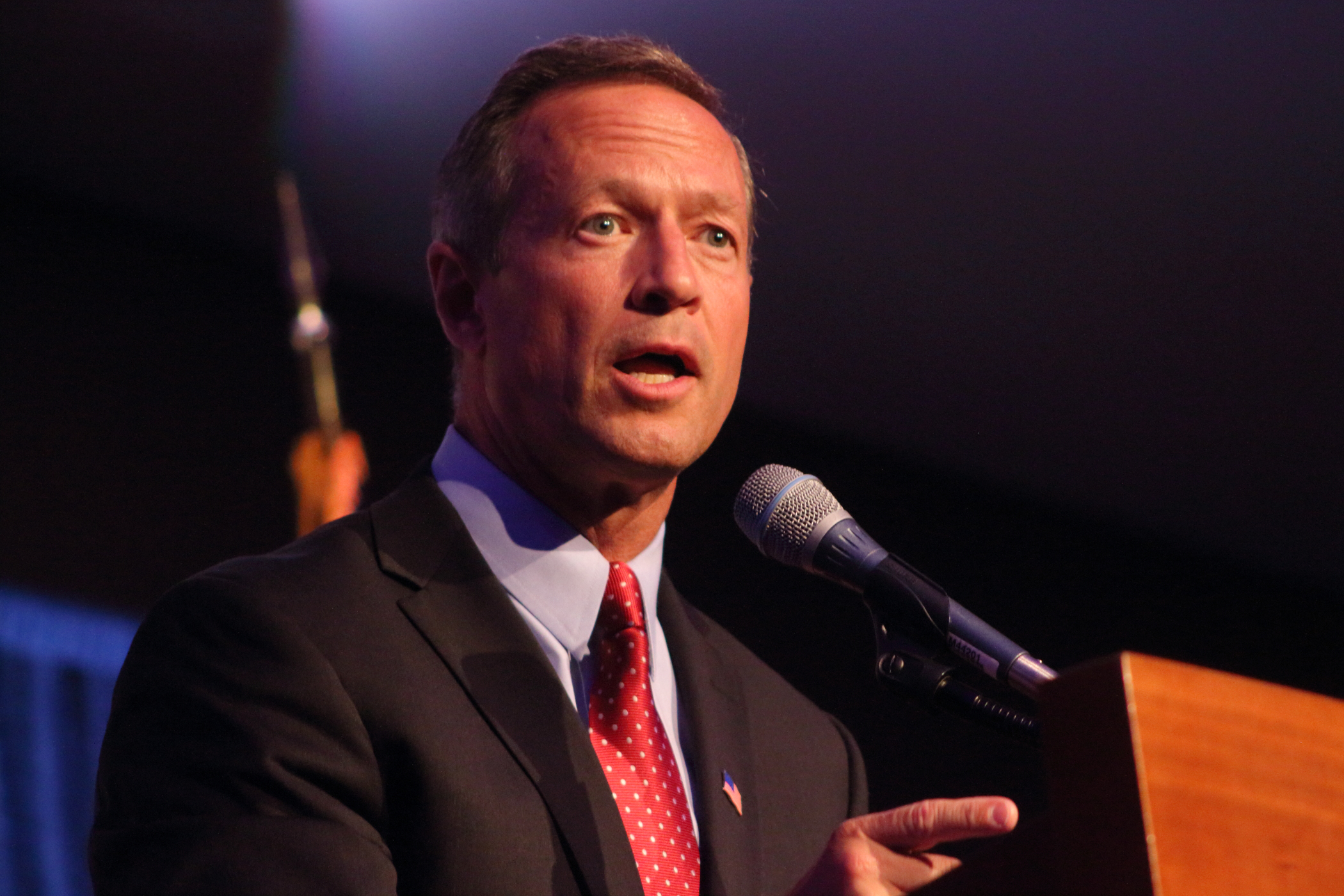
Martin O'Malley, former Governor of Maryland and former Mayor of Baltimore, pledged to make electric power generation carbon-free by 2050. (Photo: Gregory Hauenstein, Flickr CC BY-NC-ND 2.0)
[APPLAUSE]
...And certainly is not prepared to go forward aggressively. This is a moral issue. We have got to be extremely aggressive in working with China, India, Russia.
COOPER: Senator, thank you, Senator.
SANDERS: The planet, the future of the planet is at stake.
COOPER: Secretary Clinton, I want you to be able to respond, then I'm gonna go to (ph) (inaudible).
CLINTON: Well, that's exactly what I've been doing. When we met in Copenhagen in 2009 and, literally, President Obama and I were hunting for the Chinese, going throughout this huge convention center, because we knew we had to get them to agree to something, because there will be no effective efforts against climate change unless China and India join with the rest of the world. They told us they'd left for the airport; we found out they were having a secret meeting. We marched up, we broke in, we said, "We've been looking all over for you. Let's sit down and talk about what we need to do." And we did come up with the first international agreement that China has signed. Thanks to President Obama's leadership, it's now gone much further.
COOPER: Thank you.
CLINTON: And I do think that the bilateral agreement that President Obama made with the Chinese was significant. Now, it needs to go further, and there will be an international meeting at the end of this year, and we must get verifiable commitments to fight climate change from every country gathered there.
CURWOOD: In that exchange Senator Sanders referred to carbon tax legislation he and California Democrat Barbara Boxer offered in the Senate in 2013, when, by the way, the price of gasoline in the US was about $3.50 a gallon. Senator Sanders explained the carbon tax plan in detail to LOE at the time – here’s a portion of that interview.
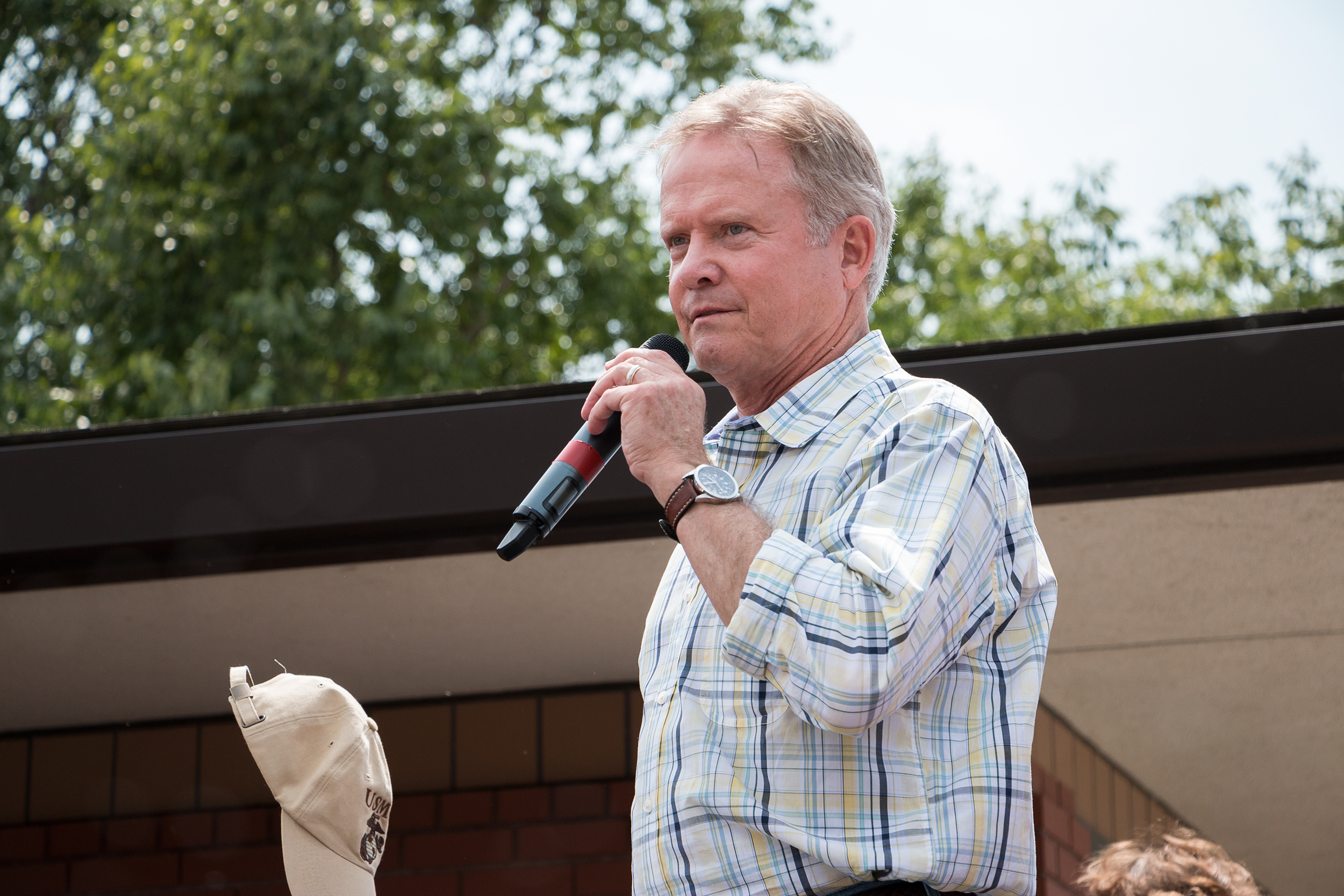
Jim Webb, previously a Republican, is a former U.S. Senator for Virginia and former Secretary of the Navy. He was the only candidate onstage who did not mention climate change in his opening statement. (Photo: John Pemble, Flickr CC BY-ND 2.0)
CURWOOD: So the centerpiece of your bill is what you're calling a fee and dividend on carbon emissions. How would that work?
SANDERS: Well, the good news here is that what we are doing is focusing on the 3,000 largest emitters of greenhouse gas in the country, putting a fee of $20 per ton of carbon or methane equivalent.
CURWOOD: So this will be what, the oil refinery?
SANDERS: Coalmines, the oil refineries, the natural gas processing plants, or at the point of importation as well - which would deal with about 85 percent of the greenhouse gas emissions. So this is not going to be a fee, which impacts tens and tens and tens of thousands of entities. It's kind of what we call an "upstream”, where the emissions take place.
CURWOOD: So how exactly would it work? How would you impose this?
SANDERS: Look. Here’s the point. Here's the point before we get into all of the details. The important issue to understand right now is that according to the scientific community, we stand the danger of seeing the planet earth temperature rise by 8°F by the end of this century. If that happens, and we’ve talked to many of the leading scientists who study this issue, what they are telling us is this will cause catastrophic - underline catastrophic - damage to the planet. What we already know is that 12 out of the last 15 years have been the warmest on record. We already know that we’re looking at unprecedented levels of drought, of floods, of extreme weather disturbances like Hurricane Irene or Hurricane Sandy. We’re looking at the continent of Australia burning up. We’re looking at heat waves in Europe the people have never seen before.
The most important issue before we worry about every line of any legislation is: Is the Congress of the United States going to wake up and say we have a planetary crisis here and we have got to address it? And if you ask me, and I already deal with a lot of issues out there, my greatest embarrassment of being a member of the United States Congress right now, it is that you have a major political party, the Republican Party, who refuses to listen to what the scientists are saying. You have the ranking member, from a ranking member of the Environmental Committee telling us if you could believe it, that the climate change is a hoax perpetrated by Al Gore and the Hollywood elite and the United Nations. I mean that's where we are. And my fear is that if Congress does not get our act together, you're gonna see more and more extreme weather disturbances, more and more problems which will cost this country and this planet a hell of a lot more than the legislation that Barbara Boxer and I have introduced.
CURWOOD: This carbon fee, this effective carbon tax, where would the money raised from these fees go?
SANDERS: Good question. Among other things, a lot of the money - actually the majority of the money - would go back to the people of United States to help them with any increased energy costs they may incur as we begin to transform our energy system away from fossil fuels. Will some people be forced to pay more for fuel? They will. A lot of money we’re raising, we expect to raise about $1.2 trillion over a 10-year-period. The majority of that money goes right back to the American people to help them pay for increased fuel costs. Significantly we also put a whole lot of money in weatherization, we would rather weatherize a million homes a year. We would put money into research and development for breakthroughs in energy...how can we move more aggressively to sustainable energy? A lot of research being done out there, and we want to be cutting edge in that. We would also invest in worker training to make sure that we had the people available to do the work that we need to transform our energy systems. So, by the way, this also becomes a jobs program because we can put a whole lot of people to work in energy efficiency and weatherization and in sustainable energy.
CURWOOD: So quickly to bring it down to the individual listening to this, maybe he works in Wyoming, drives this truck hundred miles a day to get to work and is worried about the price of gas going up. How does it help him?
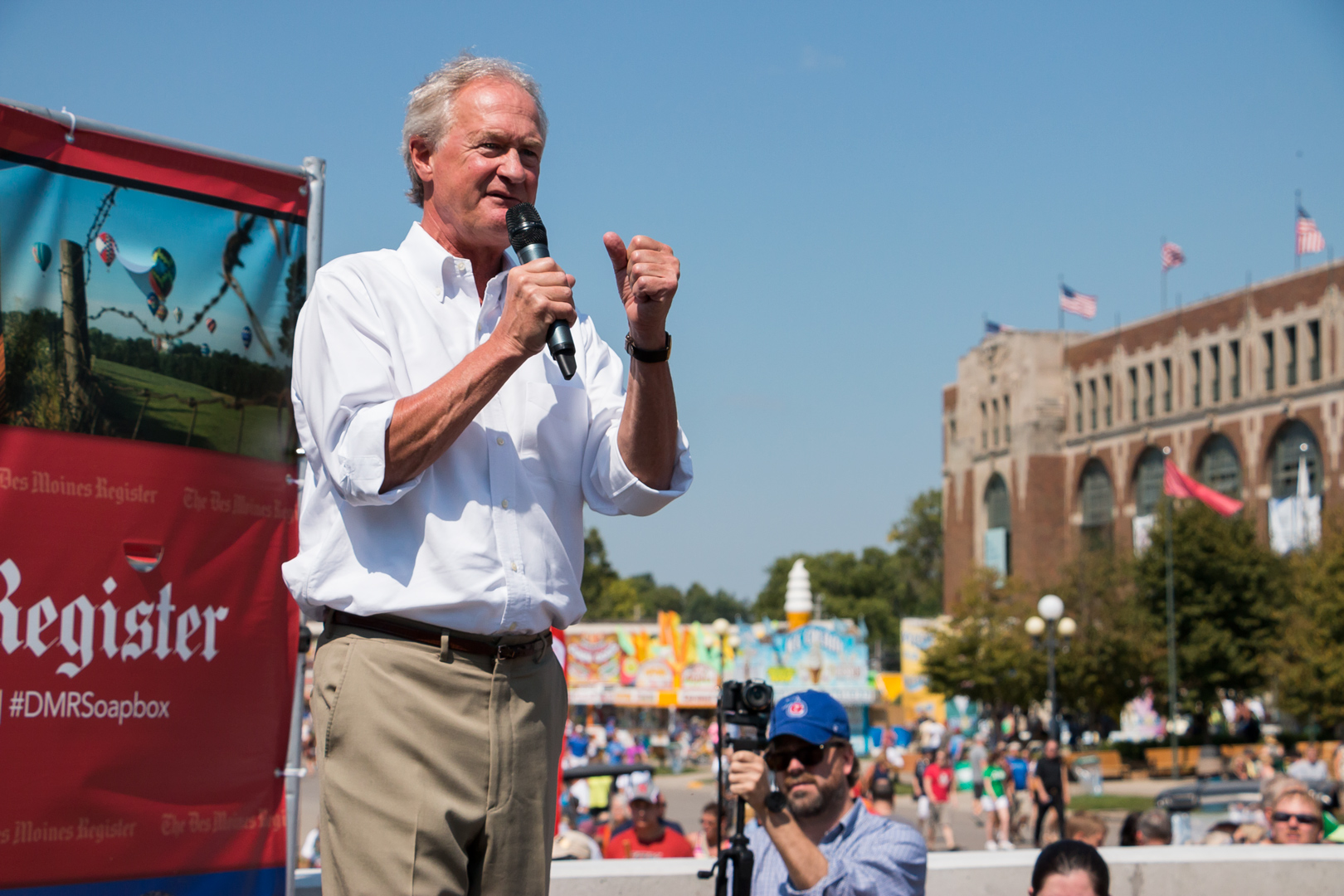
Lincoln Chafee is the former Governor of Rhode Island. He also previously served as a U.S. Senator and Mayor of Warwick. (Photo: John Pemble, Flickr CC BY-ND 2.0)
SANDERS: It helps him because we would be creating a nation in which his grandchildren and his children would be able to live comfortably. If we do nothing, if we do nothing, the projections are that the droughts that were seeing in the southwestern part of this country, the forest fires that we’re seeing, will only intensify. So the main point to be made is that we don't have much of a choice on this. If we want this planet to be habitable for our kids, grandchildren and great-grandchildren, we have to act.
CURWOOD: Vermont Senator Bernie Sanders, speaking in 2013 about how he would tax carbon to fight climate change; incidentally, the bill didn’t pass. One final note from the first debate among the Democrats: Lincoln Chafee didn’t get much of an opportunity to lay out his climate plans, but there was one question where he didn’t miss a beat.
COOPER: You've all made people upset over your careers—which enemies are you most proud of?
CHAFEE: I guess the coal lobby. I've worked hard for climate change and I wanted to work with the coal lobby. But in my time in the Senate, tried to bring them to the table so that we could address carbon dioxide. I'm proud to be at odds with the coal lobby.
Thanks to CNN for the audio, and the Democrats’ next debate is on November 14th.
Related links:
- Climate change features heavily in the first Democratic debate
- It’s Wonderful to Watch Democrats Compete Over Climate Change
- The Sanders-Boxer Climate Protection Act
- About the carbon fee and dividend policy proposal
[MUSIC: Jeremy Slater, The Carbon Cycle Song]
CUTWOOD: Just ahead...a former coal baron on trial. Stay tuned to Living on Earth.
[CUTAWAY MUSIC: Willie Nelson, Merle Travis, Dark As A Dungeon, Country Music, Rounder Records 2010]
The King of Coal On Trial
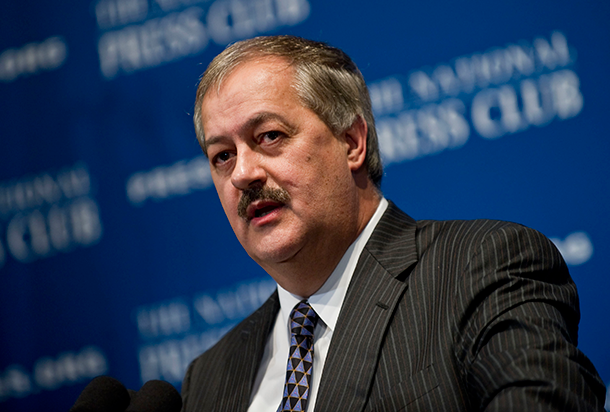
Don Blankenship (Photo: Rainforest Action Network, CC BY-NC 2.0)
CURWOOD: It’s Living on Earth. I'm Steve Curwood. Coal powered the industrial world for almost two centuries but in the US it’s now in a precipitous decline, undercut by cheaper natural gas from fracking and its climate and health hazards. Miners have died by the thousands underground, and on April 5th, 2010 the worst American mine disaster in 40 years occurred at Massey Energy’s Upper Big Branch mine in West Virginia. A huge explosion ripped through the mine, destroying the rail lines underground and killing 29 of the 31 men working there. West Virginia’s governor, Joe Manchin, went to the scene.
MANCHIN: Rails, train rails that go back in look like they’ve been twisted like a pretzel. That’s horrific. That’s an explosion that — it’s just beyond proportion.
CURWOOD: In that disaster, miner Tommy Davis lost his brother, his nephew – and his son Cory. He remembered the last time he saw his boy.
DAVIS: I kind of turned around and walked away from him, he’s like, ‘What, Dad?’ I said, ‘I love you, buddy’. He said, ‘I love you, too, Old Man. Now I’m gonna go cut me some coal.’ That’s my last words I heard from him.
CURWOOD: Well, Don Blankenship, former CEO of Massey Energy, is now on trial in connection with that mine catastrophe. Blankenship was one of the most powerful coal barons, who brooked no delays, and opposed federal safety regulation of his industry, as he told thousands of miners and their families at a Labor Day picnic in 2009.
BLANKENSHIP: As someone who has overseen the mining of more coal than anyone else in the history of central Appalachia, I know that the safety and health of coal miners is my most important job. I don’t need Washington politicians to tell me that, and neither do you.
[CROWD CHEERING]
BLANKENSHIP: But, I also know, I also know that Washington and state politicians have no idea how to improve miner safety. The very idea that they care more about coal miner safety than we do is as silly as global warming.
CURWOOD: Don Blankenship speaking in 2009. Well, to mark the start of the former CEO’s criminal trial for allegedly lying about violating safety standards at the Upper Big Branch mine, Tim Murphy, a writer for Mother Jones magazine, published a profile called The Fall of the King of Coal. Tim Murphy joins us now. Welcome to Living on Earth.
MURPHY: Thanks for having me.
CURWOOD: So you call your piece "The Fall of the King of Coal". Who is Don Blankenship and how did he become the king of coal country in the first place?
MURPHY: Don Blankenship is, I think, as he would like you to believe, a simple man from Mingo County, West Virginia, which is one of the poorest counties in the United States along the border with Kentucky along the Tug Fork River. His mom ran a gas station and pulled the family up by its bootstraps. He was an accountant who worked at a coal mine to pay his way through college and then ending up rising through the ranks of a company called Massey which at one point was a family coal company, and with Blankenship at its helm it grew into the largest coal producer in central Appalachia and one of the largest coal companies in United States. And Blankenship did all this by running it essentially with an iron fist and starting to control, developing control of the political culture of West Virginia. He helped build the West Virginia Republican Party basically up from scratch to the point where it now runs the state legislature and has a number of national elected positions in the state. And he did this also by flouting federal mine safety rules and by crushing the labor unions. So he very handily built a pretty notorious reputation, even, you know, in an industry that has not always had a great reputation.
CURWOOD: Now, in this piece you have a picture of Blankenship's estate, and it is this giant castle atop a beautiful West Virginia mountain, but, of course, he was known for tearing off the tops of those same mountains for strip mining. What was Don Blankenship's attitude towards the environment there in West Virginia?
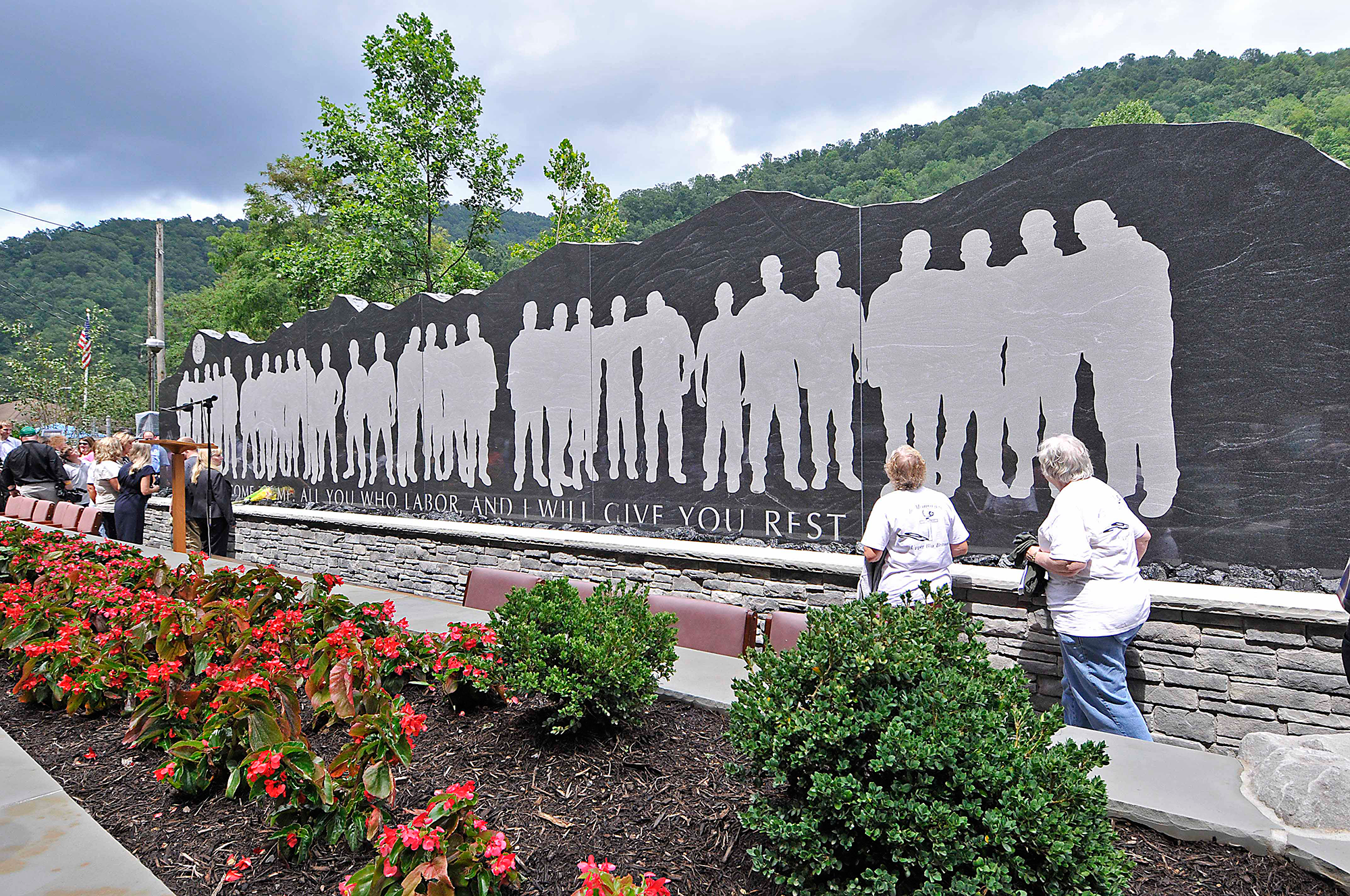
Memorial for the miners who lost their lives in the Upper Big Branch Mine disaster (Photo: Governor Earl Ray Tomblin, Flickr CC BY-ND 2.0)
MURPHY: I don't think he really put too much thought into the environment in Massey's case. They have a number of former mountain top removal sites otherwise known as surface mining sites that have been reclaimed which is the word that they use, and essentially you spray a chemical product called hydro-seed that plants all these non-native grasses on what has gone from being a scenic Appalachian knob into something more like a golf course. So that's essentially the end product of the mountain top removal site if it's effective, but in Massey Energy's case, some of their subsidiaries also had a lot of issues in terms of what happened with their coal waste. So, for instance, one of the largest environmental disasters in American history was in Eastern Kentucky just across the river from where Don Blankenship grew up and in that case the site owned by Massey had a ton of coal slurry that had been contained. It's essentially like a dam of coal waste, and the dam burst and it went out through an underground abandoned mine that was also owned by the company and ended up shutting down the water supply in about 10 counties in eastern Kentucky.
CURWOOD: Now, Don Blankenship was also known for his hostility towards organized labor. What was his relationship like with the coal miner's union, the United Mine Workers of America?
MURPHY: There's an irony to his relationship to the United Mine Workers, which is that the union really had its baptism in his backyard. He grew up just down the street from the town of Maitwan, West Virginia, which has been immortalized on the big screen, as really one of the pivotal moments in American labor history where there was an open air shoot out between United Mine Worker sympathizers and agents of the state and the mine companies. So there was actual bloodshed in the area's history over the right to organize, and Blankenship comes into this context and he really makes his name with the company. He started off as an office manager, and he was the president of a small subsidiary at the time, and the United Mine Workers declared a strike against Massey, and Blankenship ended up sort of at ground zero of the strike, and he held the line for about nine or 10 months. He likes to point to a TV that he owns that's covered in bullet holes that he says came from the union. It was an often-violent encounter between the company and its guards and the labor union. But at the end of the strike, Don Blankenship had won, and essentially from that point forward Massey was not a friendly place for unions.
CURWOOD: So, now Don Blankenship is on trial for a horrific disaster that occurred at his Upper Big Branch mine five years ago. What happened?
MURPHY: What happened according to MSHA, the Mine Safety and Health Administration, is that there was an accumulation of gas in the mine, and a piece of shearing equipment hit a spark. The shearing equipment is used to cut through the long wall section of the mine to get at the coal seam. There's an enormous amount of friction there. If it's not maintained properly then you're going to get sparks coming from it, the piece of machinery hitting the wall. In this case that spark created an explosion in the mine.
CURWOOD: I understand that the safety equipment that would've detected the large amount of gas in the mine was somehow disabled or dysfunctional.

Kayford mountaintop removal mine site in West Virginia (Photo: Kate Wellington, Flickr CC BY 2.0)
MURPHY: Yeah, and according to the federal government and according to the state's own independent investigation of the mine after-the-fact, virtually everything that could've gone wrong in this situation really did go wrong. There were issues with the safety equipment. There were issues with the state of the mine. It was just covered in combustible coal dust which you're required by law to clean up, and so the conditions of the mine were not right, the conditions for what happens if something goes wrong was not right, and the end result was that 29 people died and it was the worst mine disaster in 40 years.
CURWOOD: What was the company's attitude towards workplace safety? What was that like?
MURPHY: The company has really made a point during Blankenship's tenure to emphasize that safety was its number one priority. The term that Blankenship and the company used was S1 - that was their policy - safety is number one. They implemented a number of things that sort of gave the illusion of safety. So, for instance, they had a program that was essentially a rewards program for miners and if you continued to accumulate days without an injury on the job that didn't cause you to miss work, you would accumulate points, and you could take those points and bring them essentially to the company store and buy things like hunting gear.
The result, of course, was a perverse incentive and so if you had an injury at a Massey mine, it was really an incentive from your colleagues to not report injuries so that you can use these points to get stuff that you couldn't otherwise get. There were cases I think of miners getting hurt on the job and Massey management following them to the emergency room and requesting that they not take time off from work informing them instead, you know, that they can simply sit in the break room all day but they just didn't want to see their numbers take a hit from the lost time. They were notorious, especially under Don Blankenship's tenure, for relentless focus on the bottom line. He demanded reports from his mine superintendents about every half hour and if he saw that coal wasn't moving in a mine, say because they were working on a piece of safety construction, he would get on the phone. In the case of the Upper Big Branch mine where this disaster happened, that phone was literally a red phone. It was as if they're getting a call from the premier, and when you get a call from Don Blankenship, according to various workers who have worked in these mines and testified to the federal government, you didn't ignore what he said, you he went and did exactly that.
CURWOOD: Now you quote in your article...you quote Don Blankenship at a rally seven months before the Upper Big Branch disaster as saying "Washington and state politicians have no idea how to improve miner safety. The very idea that they care more about coal miner safety than we do is as silly as global warming." So I take it he wasn't a big fan of federal regulations.
MURPHY: He wasn't, and I think that really gets to the core of his significance in the era in which he operated. He managed to take a state in which mining was heavily unionized - a state that had voted democratic since the New Deal - and he managed to hammer home again and again and again that the reasons for the decline of the coal industry came from Washington and that it came from regulations, and that was kind of at the core of his political message and something that he continued to hammer on even up until the point where he was indicted. He spent a lot of money in the political area to push his anti-regulatory message while his companies were in some cases really making the case for regulation.
CURWOOD: And I gather he was quite a promoter of skepticism or denial around global warming?
MURPHY: He was, yes, I think his comments sound very similar to those of someone like Oklahoma Sen. James Inhofe. After he left Massey Energy and shortly before he was indicted, he put out his own documentary, which pushed global warming skepticism. It was called Rigged Session and it made the case essentially that EPA regulations and those kinds of things were driving America's economy into the gutter. But at the core of that argument is that there's no point to the regulations and that things like global warming are really just a hoax perpetrated by folks like Al Gore.
CURWOOD: So he does get indicted, as powerful as his political connections are as such. A federal indictment is brought against him. What's the case like against Don Blankenship?
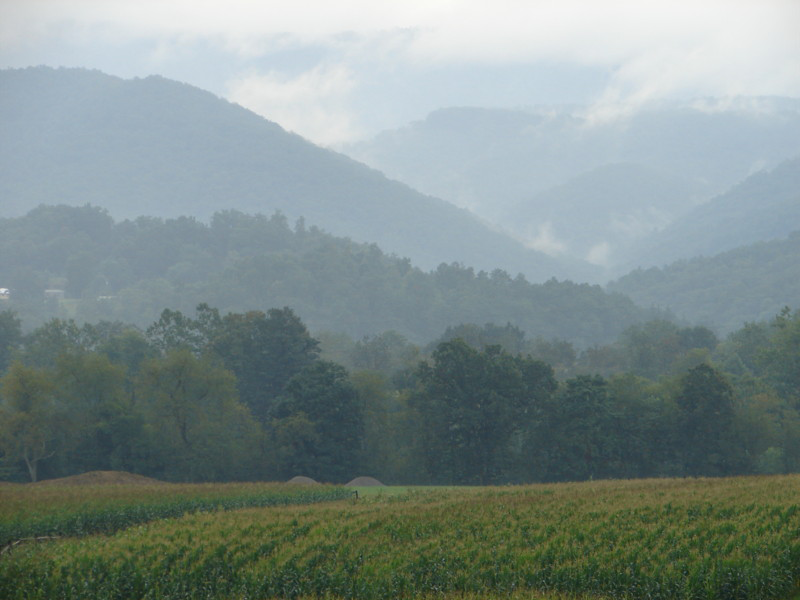
West Virginia (Photo: Jim Brickett, Flickr CC)
MURPHY: Well, I should say, the indictment in itself is kind of unprecedented. In almost every instance where there’s been prosecution in the aftermath of a disaster, they've gone after a mine foreman or something like that. So on one level the case against Blankenship is something that's new and might give people in southern and West Virginia a lot of hope that the government's finally cracking down, but then if you look at the indictment, the case actually looks a lot different. What they're actually really going after Blankenship on isn't on coal miner deaths. There's nothing about 29 deaths in a coalmine in this indictment or in this case. In fact, Blankenship's lawyers have moved to make that something that isn't even mentioned at the trial because the government isn't doing anything about its Upper Big Branch disaster. What they're trying to send him away for is lying to federal investigators and lying to the SEC about his company's safety record. So it's not that he ran rough coalmines that racked up tons of violations and had a number of fatalities. It's that he wasn't being honest with Wall Street, and that's the one that threatens to send him away for about 26 of the 30 years that he's facing.
CURWOOD: So, let me see if I have this right. He's been indicted because he said things to investors about mine safety that turned out not to be true according to the government. And so the Securities and Exchange Commission comes into play here. I imagine investors are very angry given that the price of coal at least has really just crashed in recent years. Some of the biggest companies have seen almost all of the value of the stock go away.
MURPHY: Yeah, and that's sort of the irony. I was talking to the miners in Matewan, West Virginia, when I was down there and obviously the situation for coal miners is pretty bleak right now, but as they put it, Don Blankenship is reading his company's obituaries in the newspapers that week just because Alpha Natural Resources, which is a company that bought Massey a few years back declared just two months ago. They filed for bankruptcy. So the company that bought Massey for $7.5 billion dollars is now bankrupt and looking to radically restructure its business. So over the last four, five years since Upper Big Branch, the industry has cratered. Hundreds of mines have closed and thousands of workers have been laid off. So in some level the indictment feels sort of like a bookend in the current age of King Coal.
CURWOOD: Tim Murphy is a writer for Mother Jones. His latest piece is called The Fall of the King of Coal. Thanks so much Tim for taking the time with us.
MURPHY: Thank you.
Related links:
- Tim Murphy’s story on Don Blankenship
- MSHA report on the mine disaster and corrective action plans
- Upper Big Branch Mine Disaster
- Feds Add Coal-Dust Coverup Allegation To Mine CEO's Indictment
- Coal Baron’s Trial May Hinge on His Secretly Recorded Conversations
- Massey Energy’s S-1 Safety Program
- Alpha Natural Resources Bankruptcy
- Mountaintop Removal
[MUSIC: Regina Spektor, Carbon Monoxide, Soviet Kitsch, Warner Bros, 2004]
Beyond the Headlines
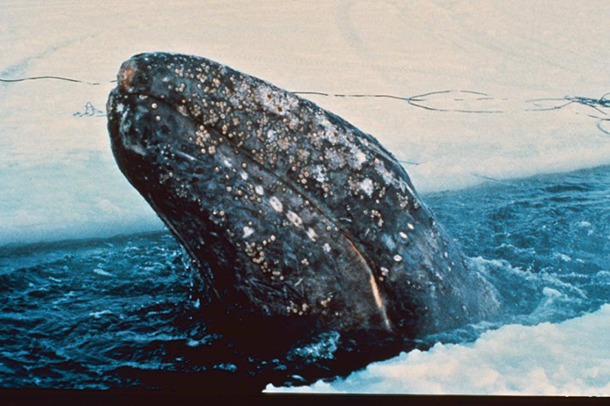
One of three gray whales trapped in the arctic. Scientists carved breathing holes in the ice for the whales. (Photo: NOAA National Marine Fisheries Service)
CURWOOD: Time now to check in with Peter Dykstra, and check out news lurking beyond the headlines. Peter’s with Environmental Health News, that’s EHN.org and the DailyClimate.org, and joins us from Conyers, Georgia. Hi there, Peter.
DYKSTRA: Hi, Steve. Remember that climate change-themed Hollywood production from about a decade ago, “The Day After Tomorrow?”
CURWOOD: Yeah, a disaster scenario for abrupt climate change. I recall that the critics were split on it, but scientists weren’t.
DYKSTRA: The scientists thought it was awful, and so did I: it was heroic climate scientist Dennis Quaid, an over-the-top fictionalization of Vice President Cheney, and Jake Gyllenhaal can’t get a cab in Manhattan because it’s under 70 feet of ice, but Jake still gets the girl. The total shutdown of ocean currents causes an Arctic deep freeze in a matter of days in a way that’s possible only in the imaginations of Hollywood writers. But a new study in Nature Scientific Reports says a less extreme version of the “Day After Tomorrow” scenario is possible if the system of air and water currents over the North Atlantic should shut down.
CURWOOD: And what happens in the North Atlantic doesn’t stay in the North Atlantic, right?
DYKSTRA: Right, in that scenario, much of Europe and North America would get colder while the rest of the world heats up. Scientists from the University of Southampton say the process might take up to a century, but its potential consequences, including exaggerated sea level rise on the U.S. East Coast, could be huge. Scientists have known about this possibility for a long time, but now there’s a new focus on it.
CURWOOD: Well, we don’t want life to imitate a bad movie. What’s next?
DYKSTRA: I want to turn to the seemingly unstoppable growth of wind power, and a man who just doesn’t seem to get the media attention he deserves, Donald Trump.
CURWOOD: Whoa, you’re saying Donald Trump doesn’t get enough media attention?
DYKSTRA: No. I didn’t say Donald Trump doesn’t get enough media attention, I said Donald Trump doesn’t get the media attention he deserves. Last week, the Donald’s British attorneys took his anti-wind farm campaign to the UK Supreme Court. He built a golf resort on the Scottish coast, which involved plowing up moors and sand dunes to install eighteen holes and a hotel where those dunes and moors used to be. But the view of a planned offshore wind farm has Trump in an uproar.
CURWOOD: So what’s new?
DYKSTRA: Well in this case, he’s worried that the golfers amidst those former moors and sand dunes will see the “monstrous blight” those wind turbines would be, and Trump is trying to get the permit for the eleven windmills overturned in the latest round of a long running battle.
CURWOOD: And however it turns out, I suppose this does count as foreign policy experience. Hey, what’s our environmental history note for this week?
DYKSTRA: A couple of things about whales: one from the 19th Century, and one from the end of the 20th Century. In October 1851, Herman Melville published one of the books that’s sometimes called the Great American Novel, Moby Dick, in which an angry white sperm whale squared off against an obsessive whaling captain who manages to track down the exact same whale that bit his leg off years earlier.
CURWOOD: Well, he did have all that 19th century technology to find that same whale in a very large ocean.
DYKSTRA: And Captain Ahab manages to lose his boat and his crew in the process. It sounds a bit like Reality TV, doesn’t it? I’ve always thought Melville’s skill was in portraying both his main characters as bad guys.
CURWOOD: Or at least a bad guy and a mad marine mammal.
DYKSTRA: Point taken. Well, in October 1988, it was our turn to obsess over whales as winter ice closed in around Barrow, Alaska. A cameraman for Barrow’s community TV station came upon three California gray whales trapped in the Arctic ice. If they couldn’t break free, the whales would die. The drama captured the town’s attention, then it captured the world’s attention. We went crazy over these three whales – reporters and whale rescuers descended upon this Arctic town – the Soviet Union sent a nuclear icebreaker to free the whales, and it’s believed two of the three gray whales eventually cleared the ice and swam south for the winter. Some scientists tried to spoil the fun by pointing out that about 200 gray whales get trapped like this every year – but not in front of a camera and without the international attention or an eventual movie deal starring Drew Barrymore.
CURWOOD: Leave it to scientists to let facts get in the way of a great story.
DYKSTRA: Every time.
CURWOOD: Peter Dykstra is with Environmental Health News, that’s EHN.org and the DailyClimate.org. Thanks, Peter. Talk to you soon.
DYKSTRA: All right, Steve. We’ll talk to you next time.
CURWOOD: And there’s more at our website LOE.org.
Related links:
- Model suggests possibility of a ‘Little Ice Age’
- Nature Scientific Reports study: Competition between global warming and an abrupt collapse of the AMOC in Earth’s energy imbalance
- Donald Trump goes to the UK Supreme Court over Menie wind farm
- Melville’s Moby Dick
- A Whale of a Tale: The Real 'Big Miracle' Story
[MUSIC: The Viscounts, written by Earle Hagen, Harlem Nocturne, 2010]
CURWOOD: Coming up...warming oceans, the blob, and the fall-out for a small seabird. That's just ahead on Living on Earth. Stay tuned.
ANNOUNCER: Funding for Living on Earth comes from United Technologies, a provider to the aerospace and building systems industries worldwide. UTC Building & Industrial Systems provides building technologies and supplies container refrigeration systems that transport and preserve food, and medicine with brands such as Otis, Carrier, Chubb, Edwards and Kidde. This is PRI, Public Radio International.
[CUTAWAY MUSIC: Charlie Hayden and Earle Jones, Wade in the Water from Steal Away, Verve/Polydor, 1995]
Coral Bleaching On the Rise
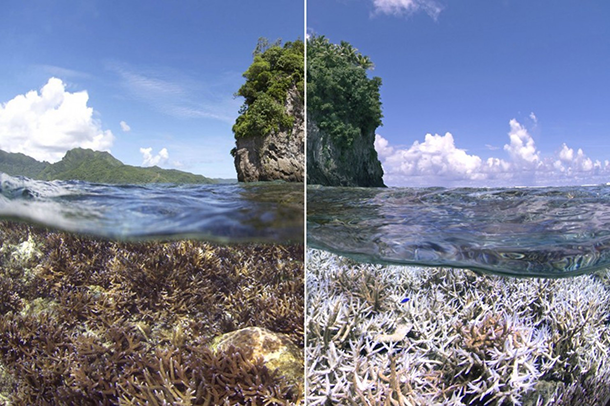
A before and after image of the bleaching in American Samoa. Images taken December 2014 and then February 2015 when the XL Catlin Seaview Survey responded to a NOAA coral bleaching alert. (Photo: XL Catlin Seaview Survey / Underwater Earth)
CURWOOD: It's Living on Earth. I'm Steve Curwood. The latest observations by NASA scientists indicate a strong El Niño has taken hold in the Pacific, and will affect rainfall, sea temperatures and storm activity into next year. Already, warmer water is adding pressure to one of the oceans’ most important and fragile habitats, coral reefs. Reefs are enchanting and beautiful, but also provide coastal protection from storms, and nurseries for fish. But now, the National Oceanic and Atmospheric Administration (NOAA) has announced that the world’s corals are turning a ghostly white, only the third such bleaching event on record. Mark Eakin is Coordinator for NOAA’s Coral Reef Watch program. Welcome!
EAKIN: Thank you, Steve, glad to be with you.
CURWOOD: So, what happens during a coral bleaching event?
EAKIN: Well, a coral is animal, vegetable and mineral. So, what happens in a coral bleaching event is that the animal part has microscopic algae living in its tissues, and the combination of those two builds the limestone skeleton that makes the massive coral reefs that they're known for. Well, when the temperature gets too high, the photosynthesis, the processes that make energy from sunlight in the algae, start to run too fast, and that releases toxins into the coral. And so the coral will eject the algae into the water so that robs the coral of the algae that gives them most of their food and gives them their color, and you can see right through to the white skeleton - and that's why it looks bleached. So the coral is still alive, but it's sick and it is starving.
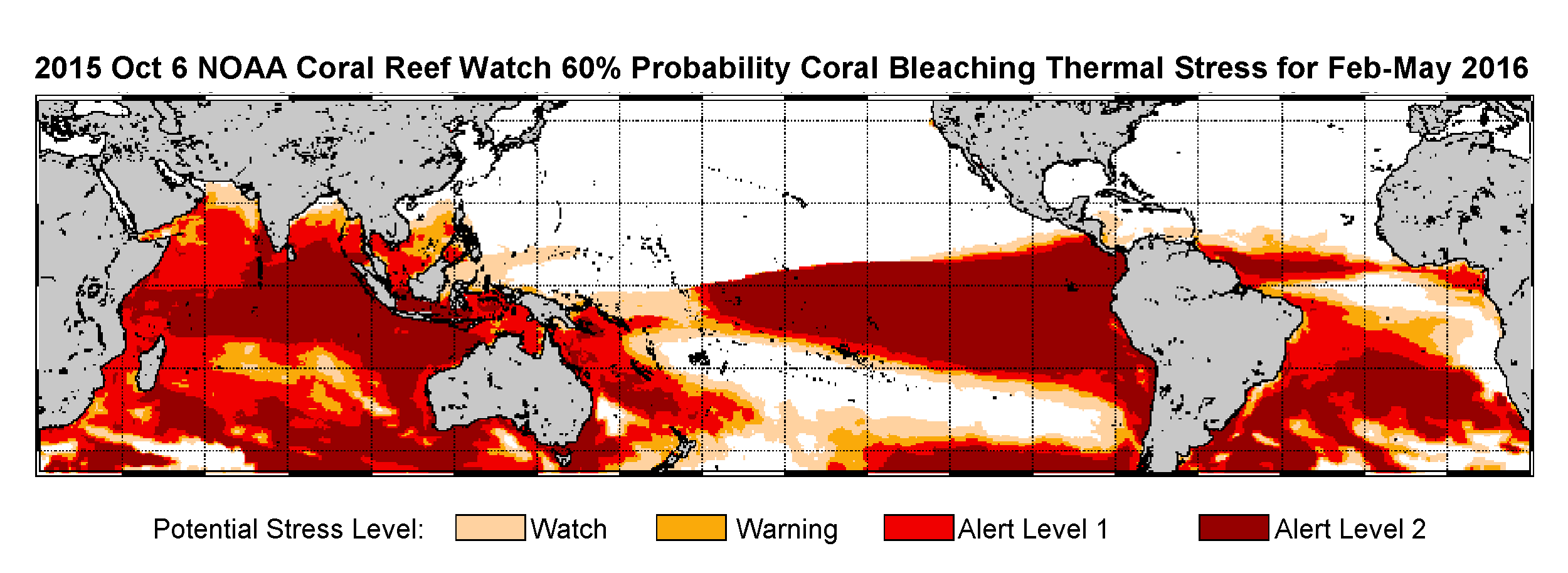
February-May 2016: An extended bleaching outlook showing the threat of bleaching expected in Kiribati, Galapagos Islands, the South Pacific, especially east of the dateline and perhaps affecting Polynesia, and most coral reef regions in the Indian Ocean. (Credit: NOAA)
CURWOOD: Now, we're in the middle of the third worldwide coral bleaching that modern science has recorded. When and where did it start and which reefs are most affected?
EAKIN: So this event actually started in June 2014 and we've had continuous bleaching of corals in various parts of the Pacific since that time. It started in the western north Pacific and the US territories of Guam and the Commonwealth of the Northern Mariana Islands, and while that was going on we started seeing bleaching in Hawaii, especially in the northwestern Hawaiian Islands, but even getting down into the main Hawaiian Islands. This is only the second time they've seen bleaching in the main Hawaiian Islands. From there, water started to warm in the Republic of the Marshall Islands, they saw the worst bleaching they've ever seen. It moved into the South Pacific and you were seeing the bleaching from the west over in the Solomon Islands, Papua New Guinea, down to the south in Fiji and to the east in the Samoas. Then we started seeing this El Nino kick in. Bleaching started across the Central Pacific in the islands of Kiribati, the Phoenix, Gilbert, and Line Islands, bleaching over in the Galapagos. After that we started seeing a normal cycle that leads to this global pattern where the atmosphere caused the Indian Ocean to start warming up. We saw bleaching in the Indian Ocean a little bit into Southeast Asia and the coral triangle, and then once we got around to the northern hemisphere, summer to fall, bleaching started in Florida, Cuba, and across the Dominican Republic and Haiti.
CURWOOD: So how much of coral around the world is likely to be affected by all of this and by the way where's the US in this picture?
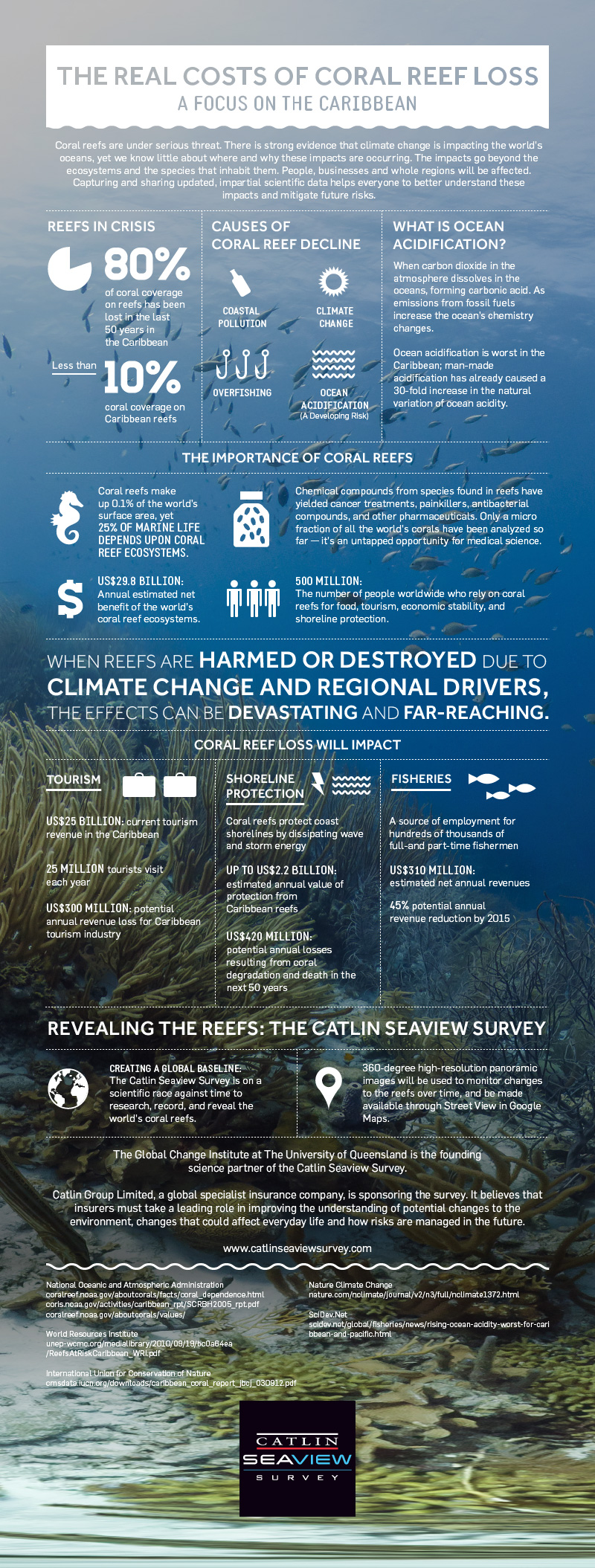
The real costs of coral reef loss (Photo: XL Catlin Seaview Survey / Underwater Earth)
EAKIN: About 38 percent probably will suffer this sort of prolonged high temperatures that cause bleaching by the end of this year globally. In the US it's actually going to be worse. We're looking at maybe as high as 95 percent, but unfortunately a lot of what we've been seeing this year was not driven by this strong El Nino right now, but by the warming that happened before that in 2014 and into early 2015. So as a result, our climate models show in 2016 the coral bleaching is likely to be even worse in some areas, and it looks like the warming in the Indian Ocean is going to be very extensive and much higher than what we saw this year.
CURWOOD: How much does water temperature have to increase for corals to get into trouble?
EAKIN: Yeah, that's the surprising thing for most people is that it's not that high. Really we usually see water temperatures of one to two and half degrees Celsius, so around one and a half to three or four degrees Fahrenheit at most above the warmest temperatures these corals normally see. Once you get past about one degrees Celsius, you are looking at enough stress that bleaching can start to kick in, and when that either goes higher or up toward 2, or when this is maintained which is usually the case of a prolonged event, that's when you start to see bleaching.
CURWOOD: To what extent can you connect the dot between all this coral bleaching around the world and climate disruption?
EAKIN: Well that's not a very long line that you have to draw. Climate change has been increasing the water temperatures very consistently over the last several decades and in fact the first bleaching events we saw were in '82, '83 with a huge El Nino maybe as big as '97, '98, but the bleaching was only in the Eastern Pacific and the Caribbean. Now we get up to ‘98, you've got a big event; it's on warmer water temperatures. You see a lot of bleaching. 2010, a moderate event, a lot of bleaching all around the world. The corals are already pushed near their limits to start with, and so doesn't take much to go on top of it. The problem we're seeing now is this event has been going on since mid-2014, and this year we’ve got the El Nino going on. We've also got this warm water mass in the northeastern Pacific called “the blob” and the two of those are conspiring with climate change to cause the bleaching that we're seeing right now in Hawaii. So we could be looking at an event that lasts at least two years, two and a half, uncertain how long.
CURWOOD: “The blob”? I'm mean, is this a bad Hollywood movie? What is “the blob”?
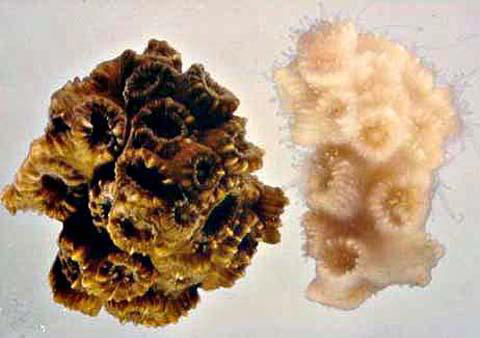
On the left, a healthy coral with its symbiotic algae. While the coral on the right is still living, it’s missing its algae, which help provide food to the coral. (Photo: NOAA, public domain)
EAKIN: The blob is a mass of warm water in the northeastern Pacific that has been around for about a year or so. It is somehow related to a variety of climates cycles like the Pacific decadal oscillation and the Arctic oscillation, it's probably related to climate change. There are other things that could be driving it, but to be honest, we don't really know quite what it is.
CURWOOD: How long does it take typically for reef to recover, at least start to recover, from an event like this?
EAKIN: Well, there really are two scales of recovery. First of all, when you have a bleaching event, it can take months for them to get those algae back, but when you're talking about a really severe event where the corals die, then it can take decades, and that's not even full recovery. These reefs may bounce back and look really good after 10, 15, 20 years, but all you're growing back at that point are the fast growing corals. You can't regrow a 200, 300, 400 year-old coral in 10 or 20 years.
CURWOOD: Mark Eakin is coordinator for NOAA's coral reef watch program. Mark, thanks so much for taking the time today.
EAKIN: Thank you very much, Steve.
Related links:
- NOAA Coral Reef Watch: Bleaching Alert Area
- NOAA declares third-ever global coral bleaching event
- XL Catlin Seaview Survey imaged the reefs as they bleached
- More about corals, reefs and their ecosystem function
The Pacific Coast's Starving Seabird Mystery
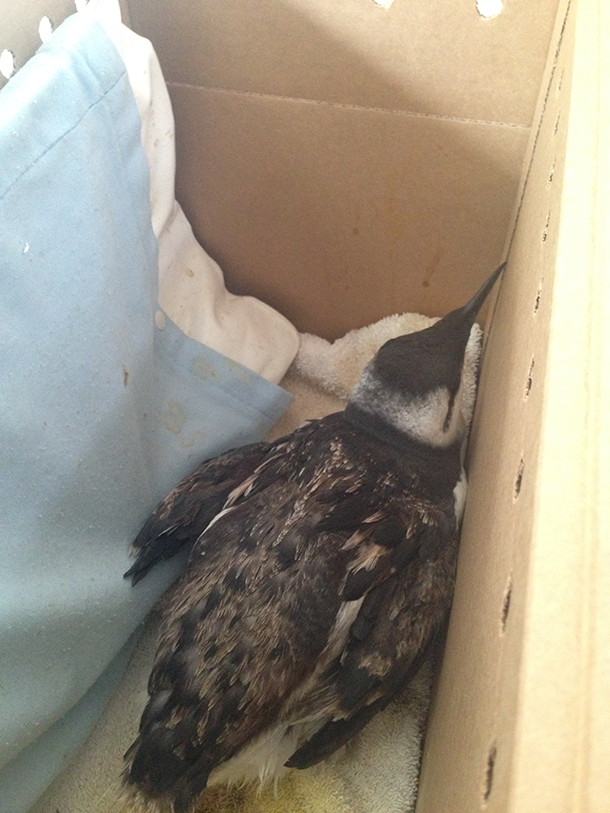
A common murre in a cardboard carrying case at Native Animal Rescue in Santa Cruz (Photo: Emmett FitzGerald)
CURWOOD: The worldwide bleaching of coral isn’t the only unusual ocean phenomenon that’s making waves this fall. Off the coast of California, a small sea bird is challenging wildlife rescue experts, as Living on Earth’s Emmett Fitzgerald has been finding out.
FITZGERALD: Unless you’re a sailor or you work on an oilrig, you’ve probably never seen a common murre. Usually these seabirds live nearly their entire lives at sea, but this summer starving murres been washing up on the Pacific Coast from Southern California to Alaska. Just about every day since the beginning of August, Eve Egan has gotten a call from a confused beachgoer saying:
EGAN: “I know this is going to sound crazy but I see a penguin on the beach”. And we say, “yeah it’s probably a murre”. Because they are about a small-sized penguin and they’re black and white like a penguin. And their legs are situated really far in the back of their body so when they do stand up, they kind of look like a penguin.
FITZGERALD: Eve and her family run a small wildlife rehab center called Native Animal Recue out of their home in Santa Cruz. They just got their first starving murre of the morning.
EGAN: This is our 348th murre for the year. Since August 4th we’ve been getting them every single day; we’ve gotten 278.
FITZGERALD: Typically Native Animal Rescue gets less than 40 murres a year. Eve says they had big years before, but nothing like this.
EGAN: When we started getting 5, 6, 10 a day, and every day this happening, we thought, “wow this is really different. This is much more than we’ve ever seen before”.
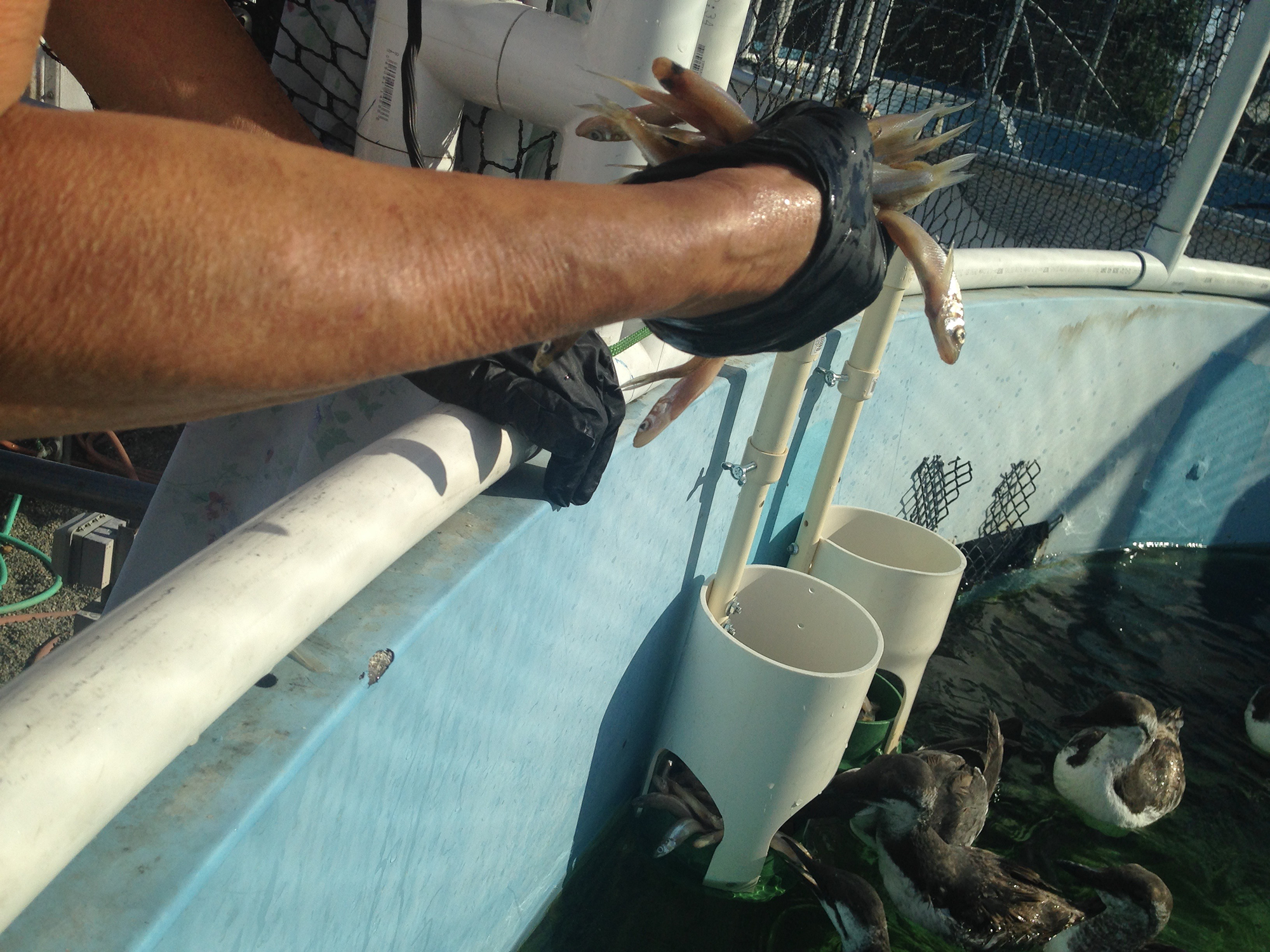
A volunteer feeds smelt to the murres. (Photo: Emmett FitzGerald)
FITZGERALD: Eve’s daughter Lupin Egan is the bird specialist in the family. She takes me back into an old laundry room they’ve converted into an intake facility. She opens up a cardboard carrying case and inside there’s a bedraggled murre.
EGAN: This one’s kind of the feathers are a little scruffy. They’re molting right now so a lot of them don’t have the wing feathers in. This is the case with this one. He’s pretty weak but he’s still got some life in him.
FITZGERALD: Lupin tube-feeds the murres until they can eat fish on their own. This bird isn’t moving much or making any noise, but it doesn’t seem to mind Lupin picking it up.
EGAN: I’ll go ahead and take him out. Use a towel to handle him and keep his head covered to keep him calmer. And then I’ll take him over here and open his mouth, and then go ahead and push the stuff down, pull the tube back out and cover him up again and put him back in his box.
FITZGERALD: If this murre survives a few more days, they’ll transfer it further north to a larger facility called International Bird Rescue up the coast in Fairfield, California.
Michelle Bellizzi is the manager of International Bird Rescue. She says that with all the murres coming in they are just about at capacity.
BELLIZZI: I know that we have 140 murres in house; I did a count today. We got in 30 yesterday, so we’ve got a full house.
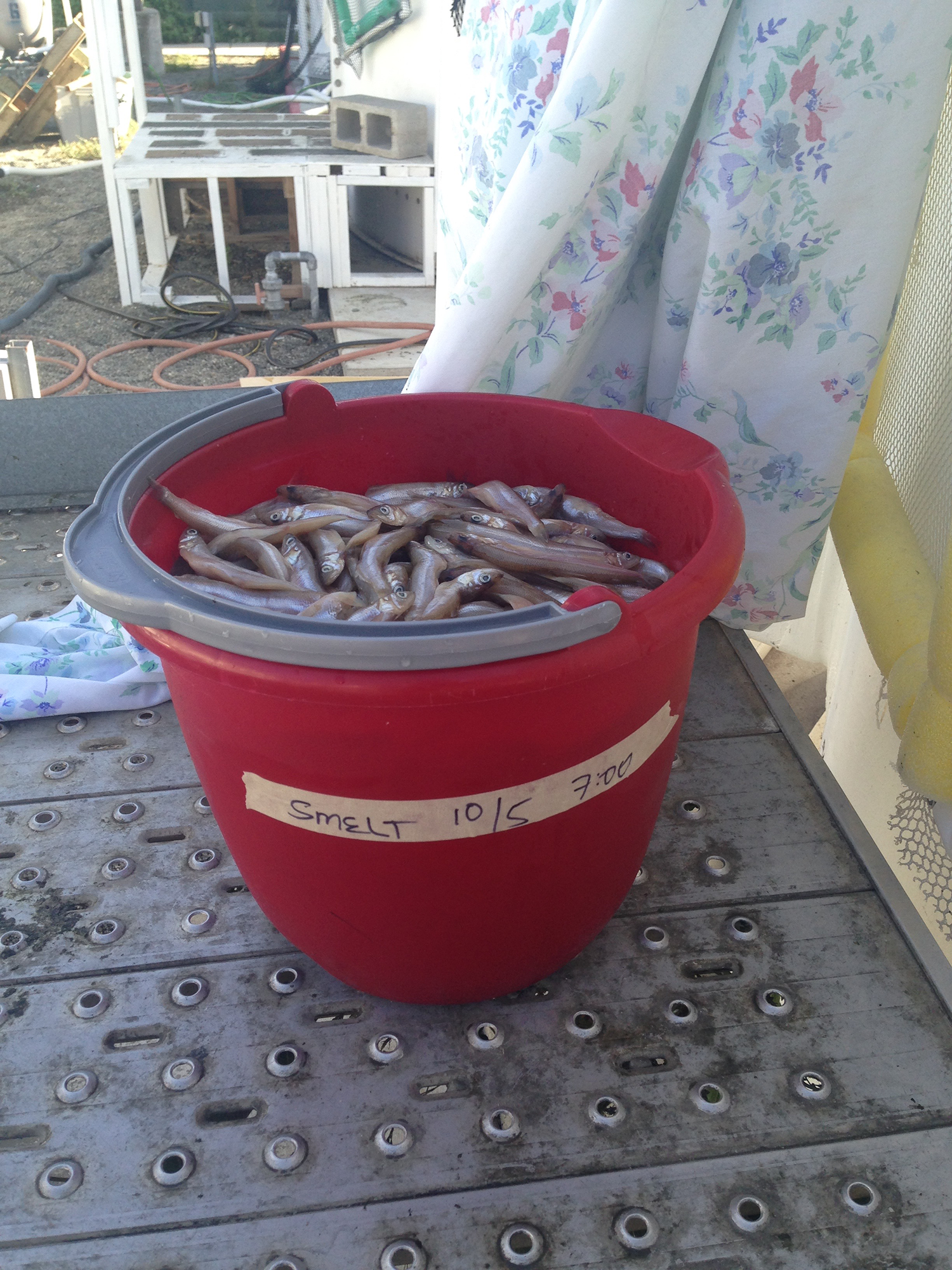
Murres can eat their body weight in fish every day. (Photo: Emmett FitzGerald)
FITZGERALD: They keep the recent arrivals inside dry crates with towels on the floor.
BELLIZZI: And what we do with these guys is, a lot of them have lost their water proofing because they’re on the beach too long and they’ve got feces or fish on them. So they come in and they can’t become waterproof. And they live entirely on water and they need to be able to live in the water full time to be able to forage. So what we do is we give them limited access to water and then we give them these nice warm pens to dry in, where they can preen their feathers and get that stuff off of them.
FITZGERALD: When they get their waterproofing back, the murres move outside into one of several circular tanks filled with water.
[MURRE SOUNDS]
There are about 30 murres in this tank. For having been so close to death, they seem in pretty good spirits. Some zip around the surface, others dive beneath each other, and one is beating the water with its wings and splashing all of us. But J.D. Bergeron, the executive director of International Bird Rescue, says you can tell these birds aren’t well.
BERGERON: Their feathers are in pretty bad shape. These birds look like sleek beautiful little penguins when they’re in their best form, you might be able to see a few that are smoother looking but most of them look pretty haggard. Our vet will kill me if I fail to mention that though they look like penguins they’re more closely related to gulls. They’re very distantly related to penguins.
FITZGERALD: The murres in this tank come from several California rescue centers like the one in Santa Cruz. So far International Bird Rescue has taken in about 500 murres this year. Michelle says that with so many coming in they depend on an army of volunteers to keep up.
BELLIZZI: Our volunteers range from college students to retirees, from Joe the plumber to rocket scientists. We actually had rocket scientists who were volunteering and who really preferred playing with cormorants. Who knew?
FITZGERALD: Jennifer Linander is a rehab technician at the center. She says one of the biggest challenges has been getting enough food to go around.
LINANDER: So we actually ordered about a thousand pounds of fish for these guys and we went through it in about a week. We ordered another 1,000 pounds but it wasn’t going to last long enough so we had to order an additional four to five hundred just to keep us going to feed all these murres, we’re going about 160, 180 pounds a day of smelt for the murres that we have in house, they can eat about their body weight in a day.
FITZGERALD: That’s a lot of money for a small non-profit. International Bird Rescue got started back in 1971 after a massive oil spill near the Golden Gate Bridge. A lot of their work comes after oil spills, but the financial equation is different this time around.
JENNIFER: You know a spill that has a responsible party like an oil spill there’s a responsible party where we get reimbursed for those. Since this is just a lack of food and all these guys that are starving that are beaching themselves and being brought here, like this is all out of our expenditure, it’s all out of our pocket, so we’re having to try to find ways to pay for all these hungry birds to eat.
FITZGERALD: The murres washing up on shore don’t have oil on them, and they aren’t sick, just hungry. Cori Gibble, the Seabird Health Program Coordinator at the Marine Wildlife and Veterinary Care and Research Center in Santa Cruz, says that it likely has something to do with the mysterious blob of warm water that’s been circulating in the North Pacific since the summer of 2014.
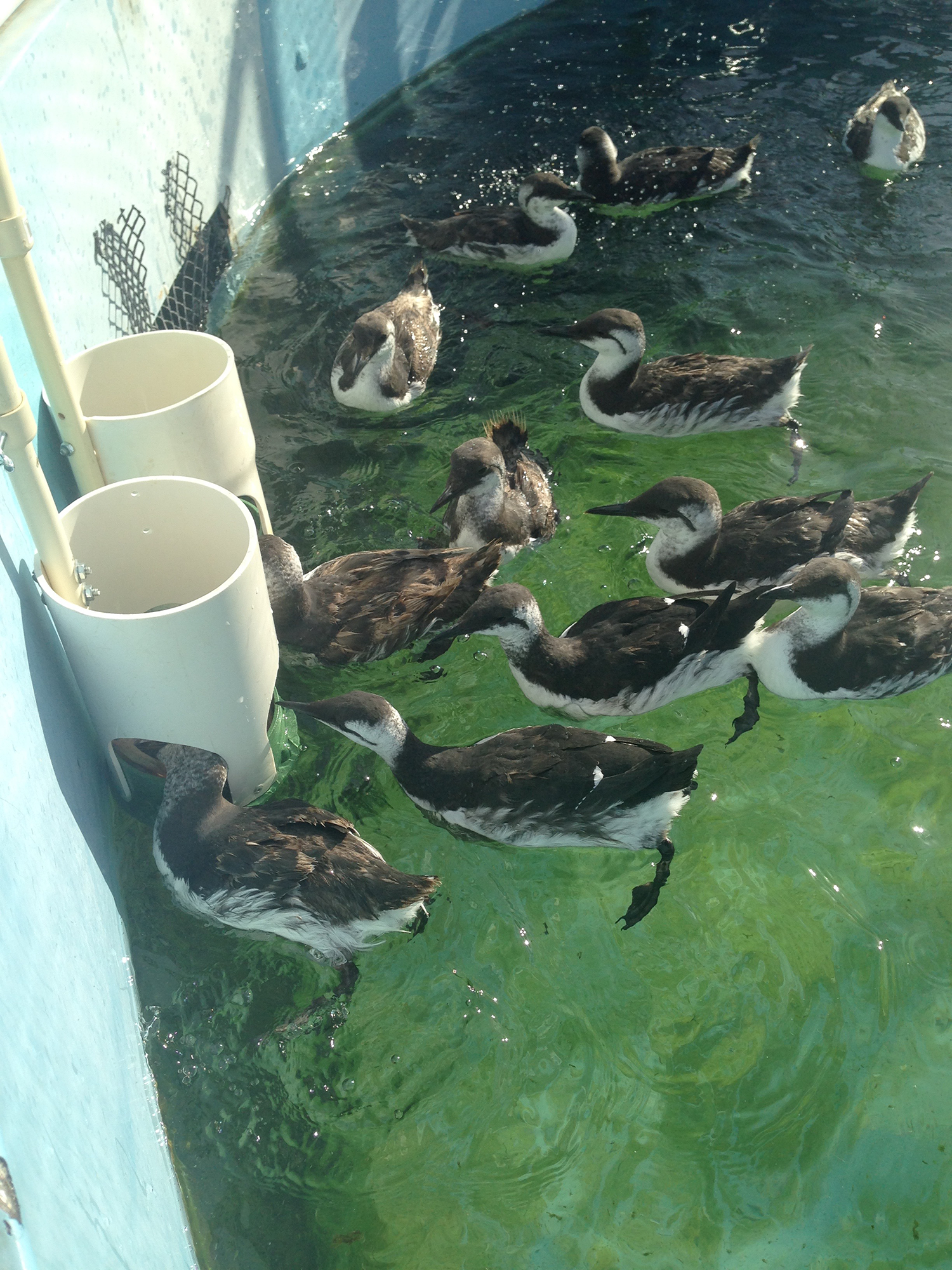
Murres swimming in a pool at International Bird Rescue in Fairfield (Photo: Emmett FitzGerald)
GIBBLE: If the water is warm or the oceanographic conditions aren’t what they normally are, then often times prey species aren’t going to be where they normally are as well and the birds aren’t going to know immediately where to go to find prey species if they’re not where they expected them to be.
FITZGERALD: Lots of other birds feed on small fish like smelt and anchovies, but murres seem to be the only species affected. Cori and other scientists have a theory about why the murre may be particularly vulnerable, and it gets back to those shabby feathers.
GIBBLE: So when murres take care of their young, they go through this period where they’re molting and they can’t fly, it’s a flightless molt, for like 1 to 2 months after their chicks are hatched.
FITZGERALD: We’re in the middle of that molting period right now, and so Cori thinks it might be limiting the murres ability to adjust to the changing location of their prey.
GIBBLE: If they happen to be flightless but they’re in an area with a good amount of food and they’re diving for their food, it wouldn’t affect them. But if they’re stuck in a place where there isn’t the right amount of food and they can’t fly somewhere else, they could have this starvation issue.
FITZGERALD: Laird Henkel, director of the Marine Wildlife and Veterinary Care Research Center, is quick to stress this is only the best theory. He says that we just don’t totally understand all of the ways climate change is impacting our ocean ecosystems.
HENKEL: One phrase people are using these days is “global weirding.” And I think that that is something that we’re seeing, the “blob” of warm water offshore is something that’s really never been seen before on this scale in the North Pacific, and I think we really don’t understand the implications of that yet, or what’s causing it exactly.
FITZGERALD: Laird says that while murres are the only seabird dying off right now, they’re clearly not the only species that is suffering from strange water patterns in the North Pacific.
HENKEL: It’s hard to piece together what’s going on with different species. So right now, common murres are mostly what we’re seeing, but then an unusual mortality event was declared by NOAA for Guadalupe fur seals. And earlier this year and last year, there was a significant mortality event for California Sea lions. So, a lot of animals feeding on forage fish in the California current have had issues over the last couple of years.
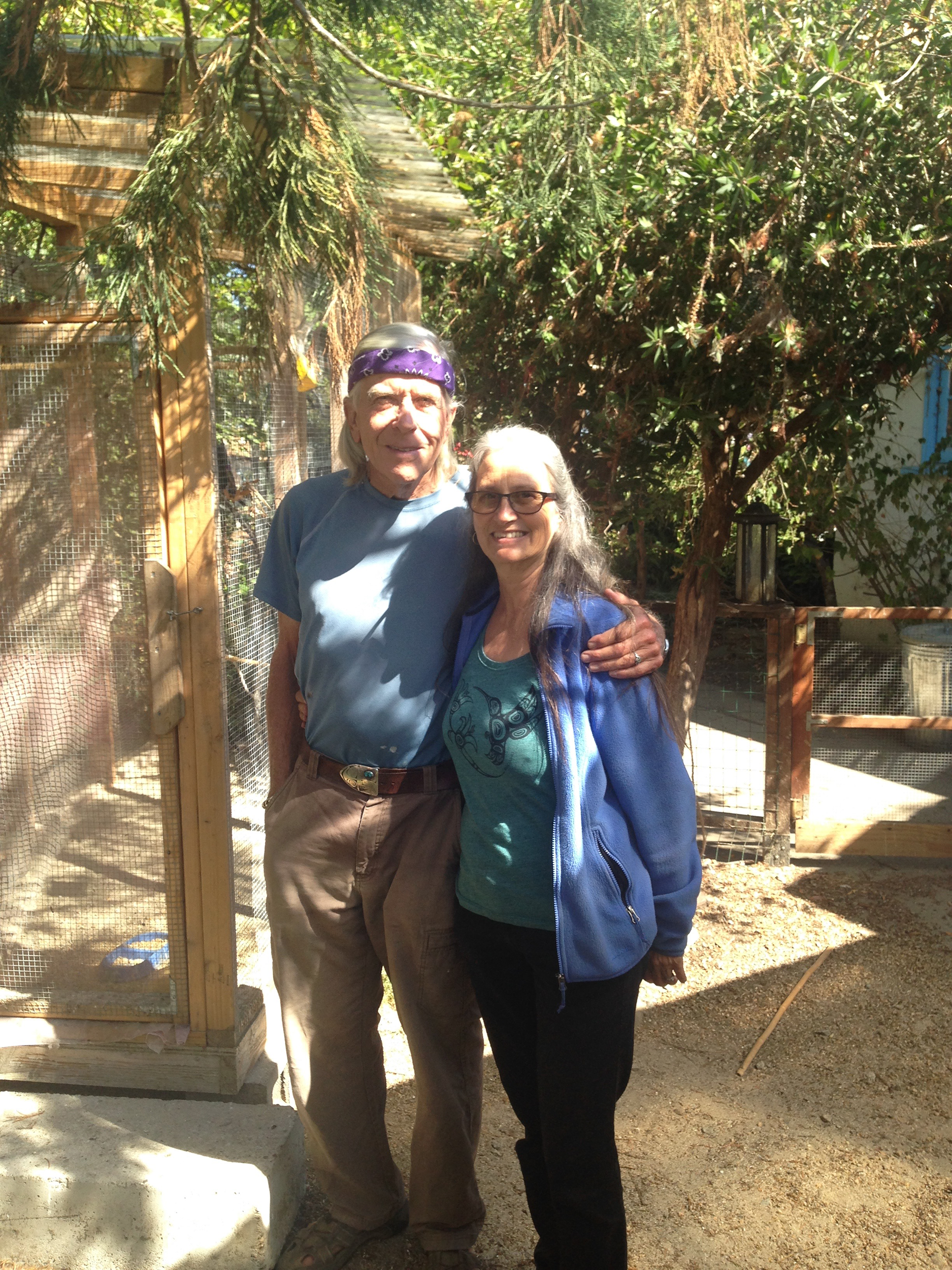
Eve and Frank run Native Animal Rescue out of their home in Santa Cruz (Photo: Emmett FitzGerald)
FITZGERALD: Back at International Bird Rescue, J.D. Bergeron says that changes in the climate change are giving them a lot more work to do.
BERGERON: So this is a facility made to handle large numbers of birds and every year we are seeing increasing numbers. This year already we had beaten last year as early as mid August we’d already surpassed it. So this is our biggest year ever.
FITZGERALD: In the past International Bird Rescue mostly responded to oil spills, but bizarre die-offs and starvation events like this one are becoming more common. J.D. worries about how climate change will affect his work in the future, but for now he’s focused on the challenge that’s immediately in front of him, getting all these birds back where they belong. He was on the boat when they released 19 murres near the Golden Gate Bridge.
BERGERON: It was amazing, they were immediately washing and preening and some of them diving, so doing all the stuff they should be doing as wild birds, right away, amazing to watch. We thought releasing 19 murres, we were actually going to see a decrease in the number in care, and then we got 30 in yesterday, so we’re not at the end of this. And we gotta just keep going until all these birds have been taken care of.
FITZGERALD: With a little luck, and a lot of effort, the murres splashing around in this tank will be back at sea soon enough.
For Living on Earth I’m Emmett FitzGerald in the San Francisco Bay.
Related links:
- International Bird Rescue
- Native Animal Rescue
[MUSIC: Baka Beyon, Land’s End, Journey Between, Rykodisc, 1998]
CURWOOD: Living on Earth is produced by the World Media Foundation and brought to you from the campus of the University of Massachusetts Boston, in association with its School for the Environment, developing the next generation of environmental leaders.
Our crew includes Naomi Arenberg, Bobby Bascomb, Emmett Fitzgerald, Lauren Hinkel, Helen Palmer, Adelaide Chen, Jenni Doering, John Duff, and Jennifer Marquis. Tom Tiger engineered our show, with help from Jake Rego, Noel Flatt and Jeff Wade. Alison Lirish Dean composed our themes. You can find us anytime at LOE.org - and like us, please, on our Facebook page - it’s PRI’s Living on Earth. And we tweet from @LivingOnEarth. I'm Steve Curwood. Thanks for listening.
ANNOUNCER1: Funding for Living On Earth comes from the Grantham Foundation for the protection of the environment, supporting strategic communication and collaboration in solving the world’s most pressing environmental problems. The Kendeda Fund, furthering the values that contribute to a healthy planet, and Gilman Ordway for coverage of conservation and environmental change. Living on Earth is also supported by Stonyfield Farm, makers of organic yogurt, smoothies and more. www.stonyfield.com.
ANNOUNCER2: PRI. Public Radio International
Living on Earth wants to hear from you!
Living on Earth
62 Calef Highway, Suite 212
Lee, NH 03861
Telephone: 617-287-4121
E-mail: comments@loe.org
Newsletter [Click here]
Donate to Living on Earth!
Living on Earth is an independent media program and relies entirely on contributions from listeners and institutions supporting public service. Please donate now to preserve an independent environmental voice.
NewsletterLiving on Earth offers a weekly delivery of the show's rundown to your mailbox. Sign up for our newsletter today!
 Sailors For The Sea: Be the change you want to sea.
Sailors For The Sea: Be the change you want to sea.
 The Grantham Foundation for the Protection of the Environment: Committed to protecting and improving the health of the global environment.
The Grantham Foundation for the Protection of the Environment: Committed to protecting and improving the health of the global environment.
 Contribute to Living on Earth and receive, as our gift to you, an archival print of one of Mark Seth Lender's extraordinary wildlife photographs. Follow the link to see Mark's current collection of photographs.
Contribute to Living on Earth and receive, as our gift to you, an archival print of one of Mark Seth Lender's extraordinary wildlife photographs. Follow the link to see Mark's current collection of photographs.
 Buy a signed copy of Mark Seth Lender's book Smeagull the Seagull & support Living on Earth
Buy a signed copy of Mark Seth Lender's book Smeagull the Seagull & support Living on Earth

